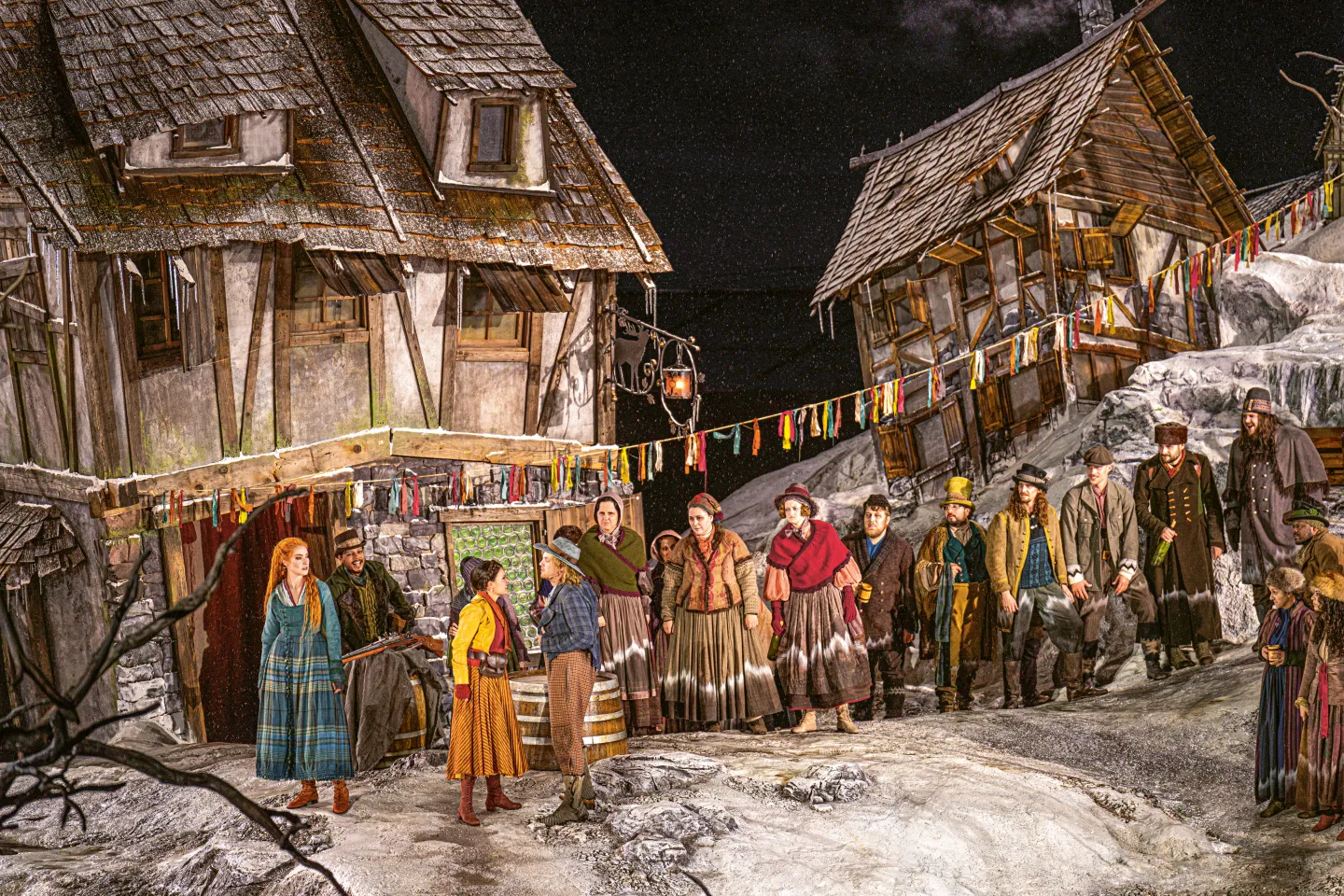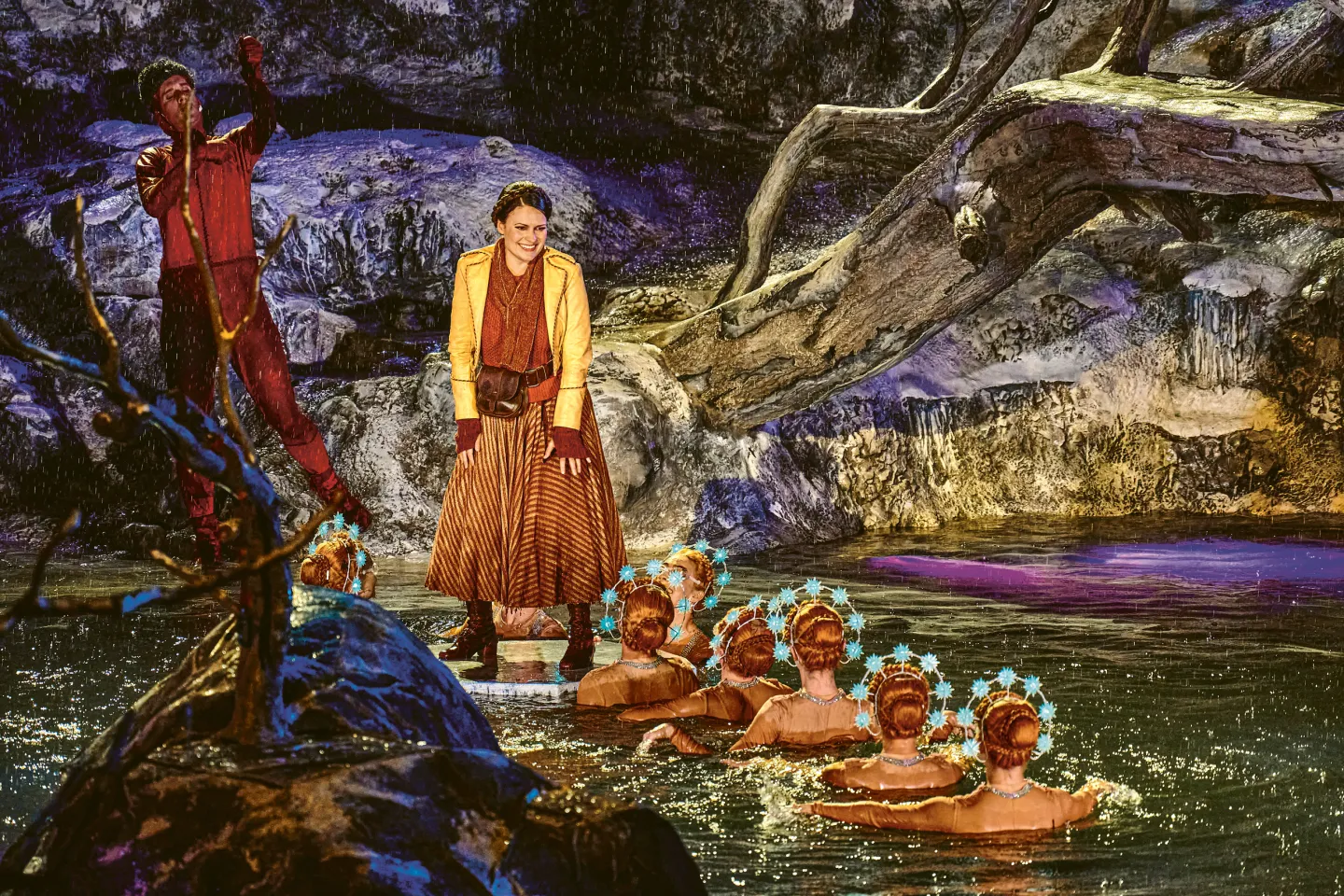Rolf App led through the interview.
The text was published in edition 2 (03/25).
Reading time 5 Min.
“I’m driven by a playful love for detail“

Costume designer Gesine Völlm put a lot of thought into giving Philipp Stölzl’s eerily beautiful production of Carl Maria von Weber’s Der Freischütz on the Seebühne in Bregenz the final visual touch. The effort is enormous.
An excerpt from Erlebnis Österreich: Der Freischütz (first broadcast in July 2024), with insights of the Bregenzer Festspiele costume studio and an interview with costume designer Gesine Völlm.
A production of ORF Landesstudio Vorarlberg.
Our audience knows your name by now: Twice already you designed the costumes for productions at the Festspielhaus – for Hamlet by Franco Faccio (2016) and Nero by Arrigo Boito (2021), both directed by Olivier Tambosi. In 2024, the Seebühne followed: Der Freischütz in the production of Philipp Stölzl. How did this collaboration come about?
Gesine Völlm: In September 2022, the artistic director at the time Elisabeth Sobotka asked me if I would design the costumes for the production. By chance, I was free for the summer 2024. I accepted immediately. I was overjoyed and immediately called Lenka Radecky, the head of the costume department.
Philipp Stölzl is not only the director, he also designed the stage. How did you coordinate your first project together?
We noticed that, aesthetically, we have a lot in common. When he was younger and working at the Münchner Kammerspiele, Philipp was the assistant of Jürgen Rose, who I learned from in Stuttgart. He says that because of this shared background he understands “the inner melody” of my Freischütz costumes so well. So, to put it in a sensuous way, there’s this sort of South German culinary influence in our aesthetic. Additionally, we both have a lot of experience and focus a lot on dramaturgical coherence. Based on our experiences with Der Freischütz we already have other projects together in mind.
How does this “culinary influence in the aesthetic” show?
When I design costumes, I am driven by a playful love for detail. And I like to add a good portion of humor into it as well. I attribute certain traits to the characters, visualize different personas – without making fun of them, but they make me smile. And that adds richness to the story.
How are you different from Stölzl?
He’s an allrounder, who can do all sorts of genres, from theater to opera and film and even music videos. And he does it with ease and confidence in his style. Although I also worked as a stage designer once, I decided to focus on costumes, my passion – and on opera. I don’t really see myself doing film yet, but maybe that will change.

Around 150 costumes were made for Der Freischütz on the lake stage, each of them is unique.
What was the first meeting like? What did you discuss?
First, he showed me what the stage would look like – with this snow-covered landscape, a dystopian, sunken village after a devastating flooding, and the frozen stretch of water at the front. There, the story is set in what feels like the Middle Ages, with magical effects and a good portion of horror. The choir was meant to create a backdrop for the more colorful soloists, like in those search-and-find puzzles. Philipp also highly recommended that I look at the winter landscapes by Pieter Bruegel the Elder. Afterwards, I went home completely happy and immediately started to collect faces of old daguerreotypes – the first publicly available form of photography – and to draw. At some point, I came across a picture of a young woman with long red hair and a petrol green dress. This had to be Agathe. Ännchen was meant to contrast her, dressed in ochre, with dark hair, more emancipated than Agathe and with an almost masculine touch.
So, you were constantly talking with Philipp Stölzl?
Yes, and that was so much fun. Because Philipp has such a strong visual imagination. When I sent him the first drafts, he replied: “To stay in the language of the opera: You really are a master markswoman!” That really inspired me. Although my costumes draw on historical clothing from the mid-19th century, they are put into a new dramaturgical context and form their very own world of costumes.
I can’t describe the joy I feel when I design and realize these costumes
The Freischütz stage in Bregenz, however, is an unusual case. Because Philipp Stölzl placed a water basin at the front, important setting for many scenes. How did this influence your costumes?
The historically inspired faux leather shoes were manufactured in Milan, one to two sizes up due to the thick neoprene socks that everybody wears and fitted with a special non-slip sole. As for the costumes, we found that handwoven materials are particularly robust. We had to make certain costumes twice so that the actors and actresses can change costumes after they play in the water. And: The soloists wear different wetsuits for hot and cold days under their costumes.
Water spirits appear during the scene at Wolf’s Glen, in Agathe’s dream there are mermaids. How difficult was this to realize?
We experimented a lot with the water spirits. Lead in the hems and weights in the pockets now keep the costumes underwater. The mermaids got goggles and waterproof lights for their star crowns.

What was it like to create and produce these costumes?
From October to December 2022, I sketched and designed. In January 2023, everyone met at the Festspielhaus for the handover. We talked about the wigs, visited the fabric storage and went over what still needed to be ordered. By May, the first prototypes had been sewn, in November we held a huge fitting with the choir. And in May 2024, just a week before rehearsals began, we started doing individual fittings – a key part of my work.
In total, 160 costumes and almost 3,000 costume pieces were produced for Der Freischütz. Were you ever afraid that you might not finish in time?
Oh no. The costumes department of the Bregenzer Festspiele is filled with so many highly skilled professionals, who all help me and do an amazing job. From material research and the first fittings to the completion and maintenance of the costumes. Just one example: 200,000 rhinestones are glued onto the mermaid’s costumes – and during every performance a few of them fall of.
Doesn’t it make you sad to know that you design costumes that disappear so quickly from people’s view?
I can’t describe the joy I feel when I design and realize these costumes. So, it does hurt a little when they disappear in the dark. But life itself is fleeting too.
Costume designer Gesine Völlm was born in Tübingen, Germany. After a tailoring apprenticeship, she started studying stage and costume design with Jürgen Rose at the Staatliche Akademie der Bildenden Künste in Stuttgart. Since 1998, she has been designing costumes for directors such as Karin Beier, Barbara Frey and Jossi Wieler. In 2005, she started focusing on opera productions and, since has regularly worked together with Stefan Herheim, Johannes Erath, Nicola Raab, Elisabeth Stöppler and Claus Guth. She has been voted costume designer of the year three times in the critics’ survey of the magazine Opernwelt.


